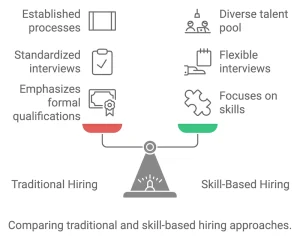Good communication is the foundation of teamwork and success. Whether you’re working on a project, giving feedback, or sending an email, the way you communicate affects how well your team collaborates.
When everyone understands each other, work gets done faster, misunderstandings are avoided, and employees feel more engaged. But what exactly is workplace communication, and how can you improve it? Let’s break it down.
What is Workplace Communication?
Workplace communication is how you exchange information with others in a professional setting. It includes verbal conversations in meetings, written messages like emails and instant chats, and even the way you use body language and tone of voice. Every interaction, whether a quick update or a detailed report, plays a role in making sure ideas are clearly understood.
The way you express yourself, the words you choose, and how well you listen all affect how effectively you communicate. Speaking in a clear and concise manner, writing messages that are easy to understand, and being aware of nonverbal cues help prevent confusion. Whether you’re giving instructions, sharing feedback, or collaborating on a project, strong communication ensures that information flows smoothly and everyone stays on the same page.

Why is Communication Important in the Workplace?
Your communication skills influence every aspect of your job. Sharing ideas, solving problems, and giving feedback all rely on clear communication to ensure others understand you as intended.
Here’s why good communication matters at work:
Helps teamwork run smoothly
When you communicate clearly, it’s easier to share ideas, set goals, and work together. Everyone knows their role, and tasks get done faster without confusion. Good communication also makes it easier to ask for help and support your teammates.
Makes work more efficient
When instructions are clear, you don’t waste time guessing or fixing mistakes. Instead of going back and forth trying to figure things out, you can focus on getting the job done. This saves time, reduces stress, and helps you stay productive.
Encourages new ideas
Open conversations create a space where people feel comfortable sharing their thoughts. When you listen to different perspectives, you can discover creative solutions to challenges. A workplace that values communication is also one that welcomes innovation.
Prevents misunderstandings
Miscommunication can lead to mistakes, frustration, and even conflict. Being clear about what you mean and making sure you understand others can help avoid these issues. The better you communicate, the smoother everything runs.
Builds strong work relationships
How you communicate affects the way people see you. Being respectful, listening well, and expressing yourself clearly help build trust with your coworkers. Strong relationships make the workplace more positive and enjoyable.
Leads to better decisions
When you have the right information, you can make smart choices. Asking questions, sharing insights, and discussing ideas with your team help you see the bigger picture. Good communication ensures that decisions are made with confidence and clarity.

Different Types of Workplace Communication
Knowing the different ways people communicate at work helps you interact better with colleagues, managers, and clients. When you understand how to use each type effectively, you can express yourself clearly and avoid misunderstandings. Here are the main types of workplace communication:
Verbal Communication
This is any form of spoken interaction, such as conversations, meetings, phone calls, and presentations. The way you speak—your clarity, confidence, and tone—affects how well your message is received. Listening is just as important as speaking, as it helps you understand others and respond appropriately.
Nonverbal Communication
Your body language, facial expressions, and tone of voice say a lot about what you’re really thinking. A friendly smile, good eye contact, and open gestures can reinforce your message, while crossed arms or a harsh tone might send the wrong signal. Being aware of these small details can help you communicate more effectively.
Written Communication
Emails, reports, memos, and chat messages fall into this category. Since you can’t rely on tone of voice or facial expressions in writing, your words need to be clear, professional, and easy to understand. Taking the time to proofread and organize your message can prevent confusion.
Digital Communication
With remote work and online tools, digital communication has become a major part of the workplace. Instant messaging, video calls, and collaboration platforms make it easy to stay connected. Choosing the right tool for the situation—like a quick chat for small updates or a video call for detailed discussions—keeps communication smooth and efficient.
Formal vs. Informal Communication
Formal communication follows professional rules, such as official emails, reports, and company policies. Informal communication includes casual chats, quick messages, and friendly discussions with coworkers. Knowing when to use each type helps you maintain professionalism while still building strong workplace relationships.
Best Practices for Communicating Effectively in the Workplace
Good communication at work takes effort, but it makes everything run more smoothly. When you express yourself clearly and listen actively, you build better relationships and avoid misunderstandings.
Here are some simple but effective ways to improve how you communicate in the workplace:
1. Be clear and get to the point.
Use simple words and avoid unnecessary details that could confuse your message. Whether you’re speaking or writing, convey what you need to in a way that’s easy to understand. A clear and respectful tone helps keep conversations productive.
2. Listen with full attention.
Communication isn’t just about talking—it’s also about listening. Give your full attention when someone is speaking, ask questions if something isn’t clear, and show that you value their input. When people feel heard, they’re more likely to engage in meaningful conversations.
3. Choose the right way to communicate.
Different messages require different ways of communicating. Quick updates are best through chat, important discussions work well over email, and sensitive topics should be handled in person or over a video call. Picking the right method helps avoid confusion.
4. Encourage open and honest conversations.
People should feel comfortable sharing their thoughts, ideas, and concerns. When you create an open communication environment, teamwork improves, and problems get solved faster. Being approachable and supportive makes it easier for others to speak up.
5. Pay attention to body language and tone.
What you don’t say is just as important as what you do say. Your facial expressions, gestures, and tone of voice can change how your message is received. A friendly, positive attitude helps build trust and makes conversations more effective.
6. Give helpful feedback.
Feedback should help, not discourage. Instead of just pointing out mistakes, focus on ways to improve and offer solutions. When feedback is constructive and supportive, it helps everyone grow and do better in their roles.

Highlight Your Skills and Capabilities with a Professionally Written Resume
Strong workplace communication is key to building great relationships, avoiding misunderstandings, and working efficiently. Whether you’re speaking in meetings, writing emails, or giving feedback, the way you communicate shapes your professional image. Mastering these skills not only helps in your current job but also makes you a stronger candidate for future opportunities.
If you want to showcase your communication skills effectively, your resume needs to highlight them the right way. At Resume Professional Writers, we create resumes that make your strengths stand out, helping you land interviews and advance in your career. Let our experts craft a compelling resume that positions you for success—because great communication deserves to be recognized.








